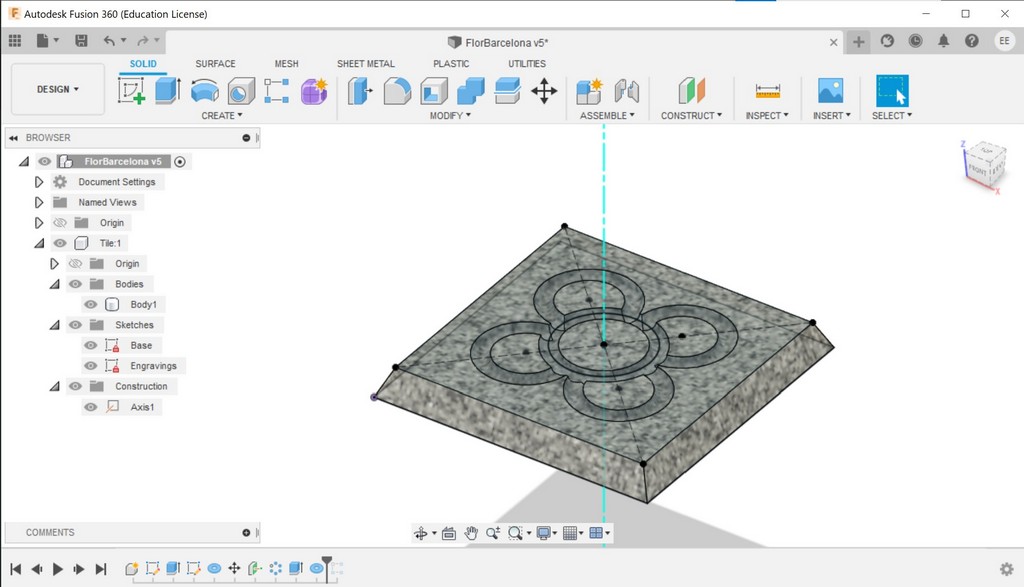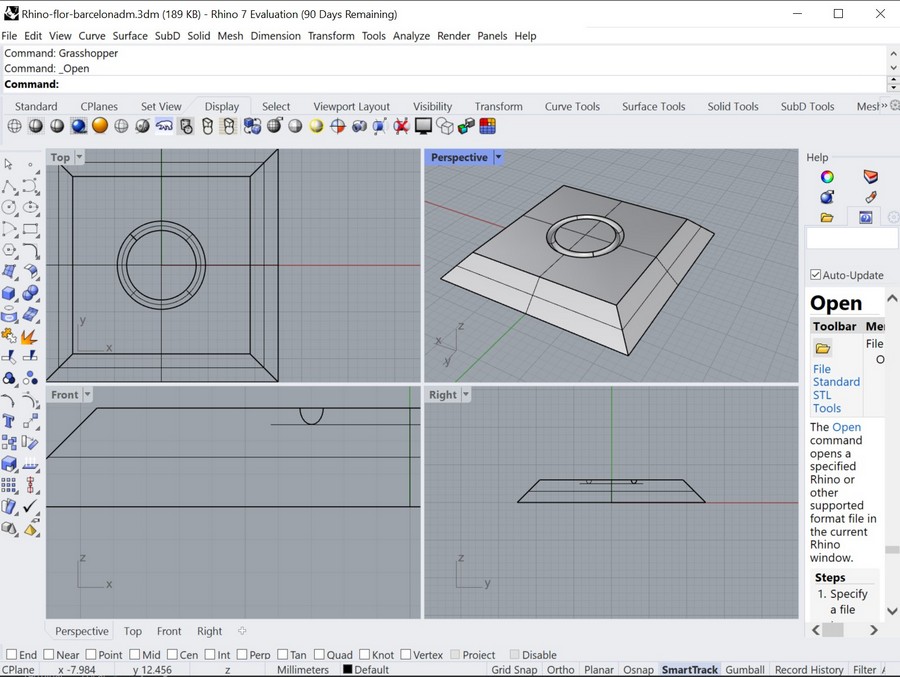CAD 3D
⬅ Go back to 2D to see how we got here.
Fusion 360
| Feature | Score | Description |
|---|---|---|
| Overall Score | 😊⭐⭐⭐⭐ | Feature rich, somewhat intuitive once you figure it out |
| Ease of use | 😊⭐⭐⭐⭐ | |
| Features | 😁 ⭐⭐⭐⭐⭐ | I have not used all of its features, but the fact that it all seems so well integrated and that you can easily jump from skething, to designing, creating high quality renders and video animations from the same interface is a huge plus |
| Learning Curve | 🙂⭐⭐⭐ | As the first 3D tool I tried out, this was both way better, way easier, and way more terrifying than I imagined. The complexity can grow so quickly if you don’t know what you’re doing. But it’s a matter of practice until you figure out the better ways to use tools |
| 👍🏻 Highlight | Timeline replay | I love the timeline at the bottom of the screen that lets you “time travel” back + make changes + fast forward/replay. It lets you easily rewrite history and not have to worry about small adjustments you might have forgotten |
| 👍🏻 Highlight | Community and Support | The amount of online tutorials, reddit threads and official documentation makes new joiners feel at ease knowing that there’s a step by step video around the corner (if you just knew the right keyword!!) |
| 👎🏻 Drawback | Cloud-centric | All your work lives on the cloud. I’d rather have a local-first product. |
I am pretty happy with the simplicity and ease of use of Fusion360.
It works as I would imagine (being a novice and not having it used before), and despite the initial learning curve, things begin to make sense after a while.
Design
With Fusion, I was able to easily design a sample tile and then create renders, videos, and animations.

Each of the different workspaces is a bit unique, but most of the features are where you’d imagine they’d be.
Rendering
The High Quality rendering engine that comes built into Fusion360 lets you focus on what’s important (the scene, etc..) and not have to worry about minor details (where should the light be positioned? How strong should the light be? etc.)

In a similar way, it was quite easy to create a render-quality turntable animation.
I was a bit disappointed with a couple of things:
- You cannot do some animations locally, even if you have the hardware for it (e.g. turntable spinning MUST be done through cloud credits = “💸 spend some of that cash €” )
- The quality of the spinning is pretty poor. It only lets you chose between 6 frames (60 degrees of spin for each step) , or 36 frames (10 degrees of spinning); which result in an animation far from “smooth”.
Rhino 7
| Feature | Score | Description |
|---|---|---|
| Overall Score | 🤔💭 | Unsure. Mixed feelings |
| Ease of use | 😐⭐⭐ | After having tried Fusion first, using Rhino becomes a bit frustrating at the beginning. Basic features (like snapping) are missing and require lots of tinkering for operations that require 1 click in Fusion |
| Features | 😁 ⭐⭐⭐⭐⭐ | The number of features that Rhino comes pack with + The features that Grasshopper plugin contributes + The number of plugins that Grasshopper supports make this a very feature rich tool |
| Learning Curve | 😐⭐⭐ | The learning curve reminded me of learning a new language (programming or not): you have a clear idea of what you are trying to achieve, you just lack the vocabulary. And why are there 35 types of “Points” in Grasshopper?. It makes sense, but it’s a steep curve until you figure out what each of the sections and subsections mean |
| 👍🏻 Highlight | Timeline replay | I love the timeline at the bottom of the screen that lets you “time travel” back + make changes + fast forward/replay. It lets you easily rewrite history and not have to worry about small adjustments you might have forgotten |
| 👍🏻 Highlight | Community and Support | The amount of online tutorials, reddit threads and official documentation makes new joiners feel at ease knowing that there’s a step by step video around the corner (if you just knew the right keyword!!) |
| 👎🏻 Drawback | Cloud-centric | All your work lives on the cloud. I’d rather have a local-first product. |
I also wanted to try out Rhino 7, since I wanted to explore parametric design using the Grasshopper plugin, and its ecosystem.
As a software developer, the promise that “you can design and express features/components without having to use the mouse” is very seductive and tempting. Thinking that any design can be expressed as a series of ordered steps (with a sequence, configuration parameters, etc…) is like being Odysseus and hearing the Sirens singing from far away.
Very interesting…
Very tempting…
Very seductive…
… and inevitably leading you to a massive crash of deadly consequences for you morale.

This is the unfinished tile after I gave up for the first time.
Lessons learned when using Rhino (to put in practice when you try to use it again to finish the tile):
- Speak the local language
- Approach things differently than in Fusion: e.g. Maybe there’s no need to snap the object at (0, 0, 0). This precision seems unnecessary, and you never see it being used in any tutorial. Maybe I should “let it go” and design things the Rhino way: with complete carelessness and reckless abandon. Just hope that the parachute works!
- Beware the mixed interface
- Rhino seems to have a mixed interface that combines mouse and keyboard. I find myself leaning towards the keyboard because I know the name of the operation that I want to perform (and I don’t know where the right button is).
- And yet, the number of different overloads and parameters that each operation takes makes this UI very messy for beginners.
- Don’t trust the magicians
- Having watched a live demo of Rhino last week in the BCN FabAcademy gave me the impression that this would be a lot easier to handle. Don’t trust the pros! They are performing an act of prestidigitation to show all the features, but you won’t learn where the commands are and you’ll feel frustrated when you find yourself unable to find a way to “filter/select/..” items from a list of edges in order to select a subset of those!
- Learning in isolation is twice as hard
- The first week of FabAcademy was fun, I got to meet new people and chat with them.
- Having to stay studying from home because I have no laptop to work from the Fab makes asking simple questions a lot harder.
Grasshopper
As you can see, I managed to create a

I will come back, and I will complete this!
Grasshopper’s Plugins
So, Rhino comes bundled with its parametric plugin (Grasshopper), but Grasshopper is so powerful and extensible that it supports plugins of its own!
After learning to install plugins into grasshopper, and figuring out where the marketplace is and how to get them, I noticed that everytime I was googling how to do a basic simple operation, I had to download a custom plugin.
I don’t fully understand why Grasshopper is unable to replicate some basic operations (like Chamfer) without requiring 3rd party plugins.
Assets
- week02.zip - Rhino/Grashopper + Krita
- FlorBarcelona.f3d - Fusion360